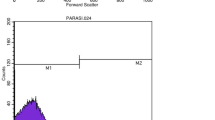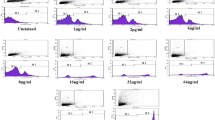Abstract
Rhesus monkey kidney cell cultures were used to propagate tachyzoites of the NC-1 strain of Neospora caninum (syn. Hammondia heydorni). The infected cell cultures were incubated for 4–12 h in media containing 0, 1, 10 or 100 µg/ml of either toltrazuril or ponazuril. The effects were studied by light and electron microscopy. Drug dosages of at least 30 µg/ml were needed to eliminate the parasites. Ponazuril was found (with respect to the reduction of the number of parasites) to be less effective at dosages of 30 µg/ml compared to toltrazuril. However, the damage to the tachyzoites being incubated in 30 µg toltrazuril or ponazuril seen by electron microscopy was so significant that it was surely lethal. The initial damage occurred within the apicoplast and the tubular mitochondrion in all cases,thus destroying two of the most important cell organelles.



Similar content being viewed by others
References
Dubey JP (1977) Toxoplasma, Hammondia, Besnoitia, Sarcocystis and other tissue forming coccidia of man and animals. In: Kreier JP (ed) Parasitic protozoa, vol III. Academic Press, New York
Gottstein B, Eperon S, Dai WJ, Cannes A, Hemphill A, Greif G (2001) Efficacy of toltrazuril and ponazuril against experimental Neospora caninum infection in mice. Parasitol Res 87:43–48
Haberkorn A (1996) Chemotherapy of human and animal coccidioses: state and perspectives. Parasitol Res 82:193–199
Hackstein JHP, Mackenstedt U, Mehlhorn H, Meijeringk JPP, Schubert H, Leunissen JAM (1995) Parasitic apicomplexans harbor a chlorophyll a-D 1 complex, the potential target for therapeutic triazines. Parasitol Res 81:207–216
Hammond DJ, Burchell JR, Pudney M (1985) Inhibition of pyrimidine biosynthesis de-novo in Plasmodium falciparum by 2-(4-t-butyl-cyclohexyl)-3-hydroxy-1,4-naphtoquinone in-vitro. Mol Biochem Parasitol 14:97–109
Harder A (2001) Chemotherapy. In: Mehlhorn H (ed) Encyclopedic references of parasitology. Springer, Berlin Heidelberg New York
Harder H, Haberkorn A (1989) Possible mode of action of toltrazuril: studies on two Eimeria species and Ascaris suum enzymes. Parasitol Res 76:8-12
Heydorn AO (1973) Studies on the life cycle of the small race of Isospora bigemina of the dog. I. Cattle and dog as possible intermediary hosts. Berl Münch Tierärztl Wochenschr 86:323–329
Heydorn AO, Mehlhorn H (2002) Neospora caninum is an invalid species name: an evaluation of facts and statements. Parasitol Res 88:175–184
Lindsay DS, Rippey NS, Cole RA, Parsons LC, DubeyJP, Tidwell RR, Blagburn BL (1994) Examination of the activities of 43 chemotherapeutic agents against Neospora caninum tachyzoites in cultured cells. Am J Vet Res 55:976–981
Mehlhorn H, Heydorn AO (2000) Neospora caninum: is it really different from Hammondia heydorni or is it a strain of Toxoplasma gondii. An opinion. Parasitol Res 86:169–178
Mehlhorn H, Heydorn AO (2003) Electron microscopic study on in-vitro cultured Hammondia heydorni (Berlin-1996)—tachyzoites after passages through dogs, mice, rats, guinea pigs and jirds. Parasitol Res 90:512–520
Mehlhorn H, Ortmann-Falkenstein G, Haberkorn A (1984) The effects of sym. triazinones on developmental stages of Eimeria tenella, E. maxima and E. acervulina: a light and electron microscopical study. Parasitol Res 70:173–182
Müller N, Sager H, Hemphill A, Mehlhorn H, Heydorn AO (2001) Comparative molecular investigation of NC5-PCR- amplicons from Neospora caninum NC-1 and Hammondia heydorni-Berlin 1996. Parasitol Res 87:883–885
Ricketts AP, Pfefferkorn ER (1993) Toxoplasma gondii: susceptibility and development of resistance to anticoccidial drugs in vitro. Antimicrob Chemother 23:58-63
Schares G, Heydorn AO, Cüppers A, Conrath FJ, Mehlhorn H (2001a) Hammondia heydorni-like oocysts shed by a naturally infected dog and Neospora caninum NC-1 cannot be distinguished. Parasitol Res 87:808–816
Schares G, Heydorn AO, Cüppers A, Conrath FJ, Mehlhorn H (2001b) Cyclic transmission of Neospora caninum: serological findings in oocyst shedding dogs. Parasitol Res 87:873–877
Author information
Authors and Affiliations
Corresponding author
Rights and permissions
About this article
Cite this article
Darius, A.K., Mehlhorn, H. & Heydorn, A.O. Effects of toltrazuril and ponazuril on the fine structure and multiplication of tachyzoites of the NC-1 strain of Neospora caninum (a synonym of Hammondia heydorni) in cell cultures. Parasitol Res 92, 453–458 (2004). https://doi.org/10.1007/s00436-003-1063-7
Received:
Accepted:
Published:
Issue Date:
DOI: https://doi.org/10.1007/s00436-003-1063-7




